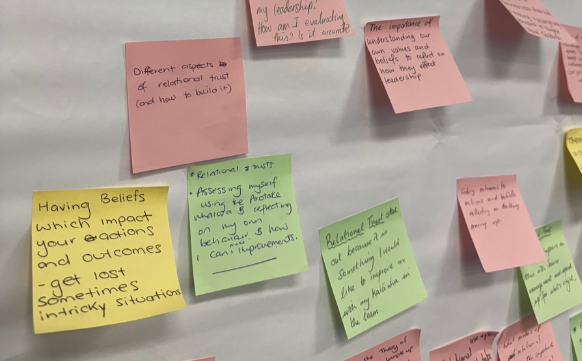Moving beyond quick fixes: a smarter way to solve complex problems
By Ben Laybourn on October 13, 2025 in Leadership
Tired of tackling the same school challenges over and over? This blog explores how Collaborative Complex Problem Solving (CCPS) can help school leaders move beyond quick fixes to create sustainable change.
Every school leader knows the frustration of a persistent challenge - the one that refuses to shift despite every new programme or initiative. You invest in professional development, you implement new programmes, you redesign your systems, but progress just won’t come. What if there was a way to move beyond ‘fixes’ and start solving for good?
We are currently working on the Te Manu Ka Rere contract, which aims to support secondary school literacy and numeracy, thereby improving achievement in Common Assessment Activities (CAA). This blog explains how a school can utilise the Collaborative Complex Problem Solving (CCPS) process to investigate the persistent issue of underachievement thoroughly.
Here is a hypothetical example, drawn from experiences across various colleges, that shows what an effective CCPS process might look like. Let’s call this school Town College, a large urban secondary school committed to achieving equitable outcomes for all its students.
Despite significant investment in professional learning and development, Town College’s Year 11 mathematics students, notably the lower performing 27%, were showing minimal progress and were unlikely to pass their CAA. The cohort had already attempted the CAA in May and September the previous year, and the current maths results showed continued underachievement. This was not just a number. It was a deeply concerning issue for the senior leadership team and staff, given the effort already invested into PLD.
To address this long-standing concern, Town College initiated a systematic inquiry process utilising the CCPS framework. This five-stage tool isn't about quick fixes; it's about deep, evidence-based inquiry into the root causes of persistent problems, leading to sustainable solutions.

Stage 1: Agree the problem to be solved
The first crucial step in CCPS is to define the student outcome problem precisely. Town College's senior leadership didn't just state, "Math scores are low." They articulated it with precision: "27% of Year 11 students were below expected levels and had made minimal progress since the May CAA, making them unlikely to pass the next assessment event in September".
They used a range of evidence, including year-level tests, e-asTTle maths assessments, PAT maths, and overall teacher judgments, to confirm this priority. This aligned everyone on exactly who was struggling and what the specific aspects of their learning needs were.
Stage 2: Inquire into causes
This is where CCPS truly separates itself from superficial problem-solving. Town College didn't jump to conclusions. They generated a comprehensive list of causal hypotheses, ranging from student factors (e.g., poor math literacy skills, student behaviour, absence) to teacher and leadership factors (e.g., teachers not using appropriate resources, lack of explicit comprehension strategies, insufficient instructional leadership).
Crucially, they then tested these hypotheses systematically, rather than relying on assumptions. For example:
Instructional leadership: senior leaders acknowledged they were "conflict-averse" and had not been sufficiently involved in inquiring into implementation or student progress. Their previous approach was to affirm positive actions and state expectations, assuming they would be met, rather than digging into difficulties.
Teachers' practice: observations by a maths facilitator and conversations with students revealed that students had very few opportunities to learn how to understand and solve math word problems. Teachers primarily used whole-class teaching, relied on worksheets over problem-solving tasks, and didn't explicitly teach how to decode word problems. Teachers admitted they were unsure how to teach math problem-solving to students so far behind, despite previous professional development.
Assessment data: teachers and leaders admitted to not using assessment data formatively enough. They were unsure how to identify next learning steps from the data and track progress as learning developed.
Student factors: while initial hypotheses included student behaviour and absence, the inquiry revealed that disengagement was closely linked to students 'feeling unsuccessful in maths and teachers’ reliance on whole-class teaching.
Through this rigorous inquiry, Town College developed a clear causal story:
‘The problem of limited intervention impact on the math results is explained by instructional leadership that is not sufficiently robust to understand and measure the impact of the intervention, math teachers not specifically teaching subject-specific literacy, and not using data effectively enough to identify learning needs or check progress, and students disengaging because of repetitive failure in math’.
This profound understanding enabled them to target the actual problems, not just the symptoms.
Stage 3: Formulate solution requirements
Based on their causal story, Town College defined exactly what any successful solution must achieve. For example:
Building leader capability: solutions must equip senior leaders with the skills to effectively inquire into the impact of interventions and provide targeted instructional support.
Enhancing teacher practice: solutions must empower math teachers with explicit strategies for teaching subject-specific literacy and comprehension, particularly for word problems, and develop their assessment literacy skills relevant to mathematics formative assessment.
Re-engaging students: solutions must provide pathways for low-performing students to experience success and rebuild confidence in math, breaking the cycle of repetitive failure.
These requirements served as non-negotiables for any strategy they considered.

Stage 4: Implement and monitor solution strategies
Town College then designed and implemented specific strategies, ensuring they had clear plans for monitoring. Examples of their strategies included:
Targeted professional development: introducing a dedicated professional learning series for math teachers on teaching math comprehension, mathematical vocabulary, and effective scaffolding of problem-solving tasks. Implementation was monitored through observation of teaching practices, buddy work with a colleague, analysis of lesson plans, and teacher reflections.
Structured instructional coaching for leaders: senior leaders engaged in an explicit coaching cycle with math department leaders, focusing on how to lead inquiry into math teaching practices and student outcomes. Monitoring included reviewing meeting minutes, observing coaching conversations, and analysing data reports presented by department leaders.
Redesigned math tasks: developing and integrating new, low-floor/high-ceiling problem-solving tasks designed to build student confidence through progressive success and varied entry points. Increase resources and explicit instruction of mathematical vocabulary, monitored by reviewing student work, observing student engagement during tasks, and collecting student feedback through surveys.
Stage 5: Evaluate impact
Finally, Town College established clear measures to evaluate the effectiveness of their solutions, focusing on both short-term progress and long-term achievement.
Short-term measures: these included increased student engagement observed in math classes, improved scores on short formative assessments focused on problem-solving comprehension and vocabulary, and positive shifts in teacher judgments regarding student confidence. This included a weekly maths task that could be used for formative assessment of progress. In the longer term, this involved school-developed short tests and EasTTle assessments that could track progress every five weeks.
Long-term measures: the ultimate goal was a significant improvement in the pass rates for Year 11 national math qualifications (CAA), alongside a broader increase in student confidence and positive attitudes towards mathematics across the year level. They regularly reviewed these metrics to understand the intervention's actual impact and adapt their approach as needed.
The power of systematic inquiry
Town College’s story shows the power of systematic inquiry. By moving through each stage of Collaborative Complex Problem Solving (CCPS), they uncovered the true leverage points for change. The result? More confident learners, more purposeful teaching, and more informed leadership. If this story feels familiar, CCPS could help you move from spinning your wheels to creating sustainable improvement. Let’s kōrero about how our CCPS workshops and tools can support your team.
While this is a hypothetical example, the validated causes are all too common in secondary schools. CCPS is not just for maths; it can be applied to any persistent challenge in your school, from literacy to wellbeing. It empowers leaders and teams to move beyond quick fixes and start truly solving, leading to sustainable and measurable improvements in student outcomes.
Ready to transform your schools problem-solving?
Explore our Collaborative Complex Problem Solving (CCPS) workshops and tools to develop the inquiry habits that drive real, lasting change.
Other articles you might like
This blog explores the hidden patterns behind leadership conversations - and how shifting from control to curiosity can unlock deeper learning and real change.
In this blog, Ben unpacks how “theories of action” shape our problem-solving, often invisibly, and why embracing double-loop learning is key to sustainable school improvement. A must-read if you're ready to move from quick fixes to deep, lasting change.
In the blog, Ben discovers how middle leaders used deliberate conversations and evidence-based inquiry to transform student achievement in reading.
